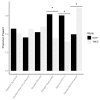Blood Metabolite Signatures of Metabolic Syndrome in Two Cross-Cultural Older Adult Cohorts
- PMID: 32079087
- PMCID: PMC7072935
- DOI: 10.3390/ijms21041324
Blood Metabolite Signatures of Metabolic Syndrome in Two Cross-Cultural Older Adult Cohorts
Abstract
Metabolic syndrome (MetS) affects an increasing number of older adults worldwide. Cross-cultural comparisons can provide insight into how factors, including genetic, environmental, and lifestyle, may influence MetS prevalence. Metabolomics, which measures the biochemical products of cell processes, can be used to enhance a mechanistic understanding of how biological factors influence metabolic outcomes. In this study we examined associations between serum metabolite concentrations, representing a range of biochemical pathways and metabolic syndrome in two older adult cohorts: The Tsuruoka Metabolomics Cohort Study (TMCS) from Japan (n = 104) and the Baltimore Longitudinal Study of Aging (BLSA) from the United States (n = 146). We used logistic regression to model associations between MetS and metabolite concentrations. We found that metabolites from the phosphatidylcholines-acyl-alkyl, sphingomyelin, and hexose classes were significantly associated with MetS and risk factor outcomes in both cohorts. In BLSA, metabolites across all classes were uniquely associated with all outcomes. In TMCS, metabolites from the amino acid, biogenic amines, and free fatty acid classes were uniquely associated with MetS, and metabolites from the sphingomyelin class were uniquely associated with elevated triglycerides. The metabolites and metabolite classes we identified may be relevant for future studies exploring disease mechanisms and identifying novel precision therapy targets for individualized medicine.
Keywords: acylcarnitines; amino acids; ceramides; diabetes; hypertension; metabolic syndrome; metabolomics; obesity; phosphatidylcholines; sphingomyelins; triglycerides.
Conflict of interest statement
The authors declare no conflict of interest.
Figures


Similar articles
-
Blood Metabolite Signature of Metabolic Syndrome Implicates Alterations in Amino Acid Metabolism: Findings from the Baltimore Longitudinal Study of Aging (BLSA) and the Tsuruoka Metabolomics Cohort Study (TMCS).Int J Mol Sci. 2020 Feb 13;21(4):1249. doi: 10.3390/ijms21041249. Int J Mol Sci. 2020. PMID: 32070008 Free PMC article.
-
Association of Coronary Artery Disease and Metabolic Syndrome: Usefulness of Serum Metabolomics Approach.Front Endocrinol (Lausanne). 2021 Sep 24;12:692893. doi: 10.3389/fendo.2021.692893. eCollection 2021. Front Endocrinol (Lausanne). 2021. PMID: 34630321 Free PMC article.
-
Multiplatform metabolomics for an integrative exploration of metabolic syndrome in older men.EBioMedicine. 2021 Jul;69:103440. doi: 10.1016/j.ebiom.2021.103440. Epub 2021 Jun 20. EBioMedicine. 2021. PMID: 34161887 Free PMC article.
-
Metabolomic and Lipidomic Signatures of Metabolic Syndrome and its Physiological Components in Adults: A Systematic Review.Sci Rep. 2020 Jan 20;10(1):669. doi: 10.1038/s41598-019-56909-7. Sci Rep. 2020. PMID: 31959772 Free PMC article.
-
Exploratory metabolomics of metabolic syndrome: A status report.World J Diabetes. 2019 Jan 15;10(1):23-36. doi: 10.4239/wjd.v10.i1.23. World J Diabetes. 2019. PMID: 30697368 Free PMC article. Review.
Cited by
-
Bile acid synthesis, modulation, and dementia: A metabolomic, transcriptomic, and pharmacoepidemiologic study.PLoS Med. 2021 May 27;18(5):e1003615. doi: 10.1371/journal.pmed.1003615. eCollection 2021 May. PLoS Med. 2021. PMID: 34043628 Free PMC article.
-
Metabolomic Profiling of Pregnancies With Polycystic Ovary Syndrome Identifies a Unique Metabolic Signature and Potential Predictive Biomarkers of Low Birth Weight.Front Endocrinol (Lausanne). 2021 Jun 15;12:638727. doi: 10.3389/fendo.2021.638727. eCollection 2021. Front Endocrinol (Lausanne). 2021. PMID: 34211435 Free PMC article.
-
Lifestyle correlates of eight breast cancer-related metabolites: a cross-sectional study within the EPIC cohort.BMC Med. 2021 Dec 10;19(1):312. doi: 10.1186/s12916-021-02183-2. BMC Med. 2021. PMID: 34886862 Free PMC article.
-
Metabolic Signatures of Type 2 Diabetes Mellitus and Hypertension in COVID-19 Patients With Different Disease Severity.Front Med (Lausanne). 2022 Jan 10;8:788687. doi: 10.3389/fmed.2021.788687. eCollection 2021. Front Med (Lausanne). 2022. PMID: 35083246 Free PMC article.
-
Metabolic profiling of pre-gestational and gestational diabetes mellitus identifies novel predictors of pre-term delivery.J Transl Med. 2020 Sep 24;18(1):366. doi: 10.1186/s12967-020-02531-5. J Transl Med. 2020. PMID: 32972433 Free PMC article.
References
MeSH terms
LinkOut - more resources
Full Text Sources
Medical

